Reconceptualizing Proximity Measurement Approaches through the Urban Discourse on the X-Minute City
Abstract
:1. Introduction
2. Data Mining
2.1. Search Strategy
2.2. Eligibility and Exclusion Criteria
- First, 3583 records were identified on the Web of Science database by using the keywords. Records (n = 3444) were excluded by the automation tools (WOS categories, language, publication years).
- In this step, the retrieved documents (n = 139) were screened through the analysis of titles and abstracts, leading to the exclusion of 55 records that were associated with other topics and irrelevant to the focus of the research.
- A Microsoft Excel spreadsheet was created to compile a list of the remaining 84 articles for full-text screening. This allowed us to methodically categorize the articles based on their titles, abstracts, problem statements, and research objectives. Any documents unavailable in full text or not presented in English were removed from consideration (n = 6).
- Upon reviewing the full text of these articles, several manuscripts had a theoretical base (n = 20). Some other articles addressed topics like measuring walkability or evaluating accessibility but did not relate to the concept of x-minute cities. Meanwhile, some articles examined factors within pre-defined minute cities (MCs) (n = 20). Therefore, these were primarily excluded due to the absence of an analytical approach in the context of the x-minute city.
- Consequently, once the screening process was carried out according to the exclusion criteria, a final database of 38 documents remained eligible to be included in this study.
2.3. Reviewing and Analysis Process
- Geographic location: Different countries worldwide have started to discuss and adopt the MC concept as an emerging trend, integrating it within their urban policies and plans. This review pinpointed countries that began to initiate new tools and methods to measure proximity and evaluate their performance as a minute city.
- The approach: The documents were classified based on whether the method used was grid-based, point of interest (POI) catchment area, building catchment area, indicator, index-based, or graph representation.
- Study area scale: It is essential to note that the choice of research objectives directly influenced how case studies were defined in terms of their scale. The reviewed documents were classified into various scales, including project, local, and regional.
- Variables used: After reviewing articles, variables were listed and organized. Variables with similar meanings were grouped under joint names. Three variable sets were generated through the reviewing process: physical, socioeconomic, and environmental-related variables. Some variables were excluded from further analysis as they were mentioned in only one document.
3. Four Results of X-Minute City in Urban Planning and Design Research
3.1. Results on Geographic Location
3.2. Results on Adopted Assessment Approaches
- Approach 1. Origin–destination OD approach/grid-based approach
- Approach 2: Point of interest catchment area approach
- Approach 3: Building catchment area
- -
- Defining the purpose and objectives: Clearly outline the purpose and objectives of establishing a catchment area. For example, a hospital might define its catchment area to ensure that it serves a specific population, or a business might want to target a particular demographic [60].
- -
- Research and analysis: Conduct thorough research and analysis to understand the demographics, population density, and other relevant factors in the potential catchment area. Utilize demographic data, market research, and geographic information systems (GIS) to gather relevant information [17].
- -
- Identify key factors that influence the catchment area, such as transportation infrastructure, competitor locations, the socio-economic status of residents, and potential demand for the services or products [48].
- -
- Consider accessibility and evaluate the accessibility of the catchment area for the target population. Consider transportation options, proximity to major roads, public transportation, and other factors affecting how easily people can reach the location [47].
- Approach 4: Mixed approach
- Approach 5: Network-based method/graph representation method
- Approach 6: Indicator and index-based method
3.3. Results on the Scale of the Study Area
3.4. Results on the Variables Used
4. Discussion: Finding the Deficiencies and Outlook
- Goal 3—Good Health and Well-being: The x-minute city seeks to enhance the well-being of residents by reducing the need for long commutes, promoting physical activity through walkable neighborhoods, and improving air quality. These aspects contribute to achieving the health-related targets outlined in Goal 3 [40].
- Goal 10—Reduced Inequality: Creating neighborhoods where essential services are accessible within short distances can contribute to reducing spatial inequalities and improving access to resources for all residents, aligning with the objectives of Goal 10 [41].
- Goal 11—Sustainable Cities and Communities: SDG 11 specifically focuses on making cities inclusive, safe, resilient, and sustainable. The x-minute city concept emphasizes reducing commuting times, promoting mixed-use development, and creating walkable neighborhoods, which aligns closely with the objectives of Goal 11 [30,40,64].
5. Conclusions, Limitations, and Future Research
Supplementary Materials
Author Contributions
Funding
Institutional Review Board Statement
Informed Consent Statement
Data Availability Statement
Acknowledgments
Conflicts of Interest
References
- Allam, Z.; Bibri, S.E.; Chabaud, D.; Moreno, C. The theoretical, practical, and technological foundations of the 15-minute city model: Proximity and its environmental, social and economic benefits for sustainability. Energies 2022, 15, 6042. [Google Scholar] [CrossRef]
- Tran, M.-C. Healthy cities—walkability as a component of health-promoting urban planning and design. J. Sustain. Urban. Plan. Prog. 2016, 1, 11–21. [Google Scholar] [CrossRef]
- Gerten, C.; Fina, S. Scrutinizing the buzzwords in the mobility transition: The 15-minute-city, the one-hour metropolis, and the vicious cycle of car dependency. Projections 2022, 16, 1–41. [Google Scholar]
- Lima, F.T.; Costa, F. The quest for proximity: A systematic review of computational approaches towards 15-minute cities. Architecture 2023, 3, 393–409. [Google Scholar] [CrossRef]
- Abusaada, H. Strengthening the affectivity of atmospheres in urban environments: The toolkit of multi-sensory experience. Int. J. Arch. Res. Archnet-IJAR 2020, 14, 379–392. [Google Scholar] [CrossRef]
- Bartzokas-Tsiompras, A.; Bakogiannis, E. Quantifying and visualizing the 15-Minute walkable city concept across Europe: A multicriteria approach. J. Maps 2023, 19, 2141143. [Google Scholar] [CrossRef]
- Abusaada, H.; Elshater, A. Effects of urban atmospheres on changing attitudes of crowded public places: An action plan. Int. J. Community Well-Being 2020, 3, 109–159. [Google Scholar] [CrossRef]
- Elshater, A.; Abusaada, H. People’s absence from public places: Academic research in the post-COVID-19 era. Urban Geogr. 2022, 43, 1268–1275. [Google Scholar] [CrossRef]
- Elshater, A.; Abusaada, H. Exploring the types of blogs cited in urban planning research. Plan. Pract. Res. 2022, 38, 62–80. [Google Scholar] [CrossRef]
- Ghanem, S.; Ahmad, A.F.; Aboualy, S. COVID-19 bringing cairenes back to their streets. J. Urban Manag. 2021, 10, 393–408. [Google Scholar] [CrossRef]
- El-Bardisy, N.; Elshater, A.; Afifi, S.; Alfiky, A. Predicting traffic sound levels in Cairo before, during, and after the COVID-19 lockdown using Predictor-LimA software. Ain Shams Eng. J. 2023, 14, 1–11. [Google Scholar] [CrossRef]
- Abusaada, H.; Elshater, A. COVID-19 and “the trinity of boredom” in public spaces: Urban form, social distancing and digital transformation. Int. J. Arch. Res. Archnet-IJAR 2022, 16, 172–183. [Google Scholar] [CrossRef]
- Schraven, D.; Joss, S.; de Jong, M. Past, present, future: Engagement with sustainable urban development through 35 city labels in the scientific literature 1990–2019. J. Clean. Prod. 2021, 292, 125924. [Google Scholar] [CrossRef]
- Elshater, A. The ten-minute neighborhood is [not] a basic planning unit for happiness in Egypt. Int. J. Arch. Res. Archnet-IJAR 2016, 10, 344–357. [Google Scholar] [CrossRef]
- Abdelfattah, L.; Deponte, D.; Fossa, G. The 15-minute city as a hybrid model for Milan. J. Land Use Mobil. Environ. 2022, 17, 71–86. [Google Scholar]
- Calafiore, A.; Dunning, R.; Nurse, A.; Singleton, A. The 20-minute city: An equity analysis of Liverpool City Region. Transp. Res. Part D Transp. Environ. 2022, 102, 103111. [Google Scholar] [CrossRef]
- Elshater, A.; Abusaada, H.; Tarek, M.; Afifi, S. Designing the socio-spatial context urban infill, liveability, and conviviality. Built Environ. 2022, 48, 341–363. [Google Scholar] [CrossRef]
- Asaad, M.; Hassan, G.F.; Elshater, A.; Afifi, S. Global South research priorities for neighbourhood sustainability assessment tools. Open House Int. 2024, 49, 45–62. [Google Scholar] [CrossRef]
- Osman, R.; Mulíček, O. Urban chronopolis: Ensemble of rhythmized dislocated places. Geoforum 2017, 85, 46–57. [Google Scholar] [CrossRef]
- Di Marino, M.; Tomaz, E.; Henriques, C.; Chavoshi, S.H. The 15-minute city concept and new working spaces: A planning perspective from Oslo and Lisbon. Eur. Plan. Stud. 2023, 31, 598–620. [Google Scholar] [CrossRef]
- Solá, A.G.; Vilhelmson, B. Negotiating proximity in sustainable urban planning: A Swedish case. Sustainability 2018, 11, 31. [Google Scholar] [CrossRef]
- Balletto, G.; Ladu, M.; Milesi, A.; Borruso, G. A methodological approach on disused public properties in the 15-minute city perspective. Sustainability 2021, 13, 593. [Google Scholar] [CrossRef]
- Ferrer-Ortiz, C.; Marquet, O.; Mojica, L.; Vich, G. Barcelona under the 15-minute city Lens: Mapping the accessibility and proximity potential based on pedestrian travel times. Smart Cities 2022, 5, 146–161. [Google Scholar] [CrossRef]
- Badii, C.; Bellini, P.; Cenni, D.; Chiordi, S.; Mitolo, N.; Nesi, P.; Paolucci, M. Computing 15MinCityIndexes on the basis of open data and services. In Computational Science and Its Applications—ICCSA; Springer: Cham, Switzerland, 2021. [Google Scholar]
- van Eck, R.; de Jong, T. Accessibility analysis and spatial competition effects in the context of GIS-supported service location planning. Comput. Environ. Urban Syst. 1999, 23, 75–89. [Google Scholar] [CrossRef]
- Ataman, C.; Tuncer, B. Urban interventions and participation tools in urban design processes: A systematic review and thematic analysis (1995–2021). Sustain. Cities Soc. 2021, 76, 103462. [Google Scholar] [CrossRef]
- Abusaada, H.; Elshater, A. Notes on developing research review in urban planning and urban design based on PRISMA statement. Soc. Sci. 2022, 11, 391. [Google Scholar] [CrossRef]
- Elshater, A.; Abusaada, H. Developing process for selecting research techniques in urban planning and urban design with a PRISMA-compliant review. Soc. Sci. 2022, 11, 471. [Google Scholar] [CrossRef]
- Wang, J.; Kwan, M.-P.; Liu, D.; Peng, X. Assessing the spatial distribution of and inequality in 15-minute PCR test site accessibility in Beijing and Guangzhou, China. Appl. Geogr. 2023, 154, 102925. [Google Scholar] [CrossRef] [PubMed]
- Willberg, E.; Fink, C.; Toivonen, T. The 15-minute city for all?—Measuring individual and temporal variations in walking accessibility. J. Transp. Geogr. 2023, 106, 103521. [Google Scholar] [CrossRef]
- Logan, T.; Hobbs, M.; Conrow, L.; Reid, N.; Young, R.; Anderson, M. The x-minute city: Measuring the 10, 15, 20-minute city and an evaluation of its use for sustainable urban design. Cities 2022, 131, 103924. [Google Scholar] [CrossRef]
- Yang, Y.; Qian, Y.; Zeng, J.; Wei, X.; Yang, M. Walkability measurement of 15-minute community life circle in Shanghai. Land 2023, 12, 153. [Google Scholar] [CrossRef]
- Page, M.J. PRISMA 2020 explanation and elaboration: Updated guidance and exemplars for reporting systematic reviews. BMJ 2021, 372, n160. [Google Scholar] [CrossRef] [PubMed]
- Mariotti, I.; Giavarini, V.; Rossi, F.; Akhavan, M. Exploring the “15-minute city” and near working in Milan using mobile phone data. J. Land Use Mobil. Environ. 2022, 2, 39–56. [Google Scholar]
- Caselli, B.; Carra, M.; Rossetti, S.; Zazz, M. From urban planning techniques to 15-minute neighbourhoods. A theoretical framework and GIS-based analysis of pedestrian accessibility to public services. Eur. Transp. 2021, 85, 1–15. [Google Scholar] [CrossRef]
- Kesarovski, T.; Hernández-Palacio, F. Time, the other dimension of urban form: Measuring the relationship between urban density and accessibility to grocery shops in the 10-minute city. Environ. Plan. B Urban Anal. City Sci. 2023, 50, 44–59. [Google Scholar] [CrossRef]
- El Karim, A.A.; Awawdeh, M.M. Integrating GIS accessibility and location-allocation models with multicriteria decision analysis for evaluating quality of life in Buraidah City, KSA. Sustainability 2020, 12, 1412. [Google Scholar] [CrossRef]
- Da Silva, D.C.; King, D.A.; Lemar, S. Accessibility in practice: 20-minute city as a sustainability planning goal. Sustainability 2019, 12, 129. [Google Scholar] [CrossRef]
- Harroucha, R.; Chaouni, A.-A. Mosques pedestrian accessibility analysis under the 15 min cities concept. GeoJournal 2023, 88, 3575–3594. [Google Scholar] [CrossRef]
- Noworól, A.; Kopyciński, P.; Hałat, P.; Salamon, J.; Hołuj, A. The 15-minute city—The geographical proximity of services in Krakow. Sustainability 2022, 14, 7103. [Google Scholar] [CrossRef]
- Zhang, D.; Ma, S.; Fan, J.; Xie, D.; Jiang, H.; Wang, G. Assessing spatial equity in urban park accessibility: An improve two-step catchment area method from the perspective of 15-minute city concept. Sustain. Cities Soc. 2023, 98, 104824. [Google Scholar] [CrossRef]
- Harroucha, R.; Chaouni, A.-A. GIS-based approach evaluating sustainable spatio-functional accessibility to mosques. Ann. GIS 2023, 29, 429–439. [Google Scholar] [CrossRef]
- Balletto, G.; Sechi, F.; Borruso, G.; Sinatra, M.; Meloni, I.; Fancello, G. Mobility and land-use system in the sport mega-events. The case of the Cagliari stadium (Sardinia, Italy). Eur. Transp./Trasp. Eur. 2023, 93, 1–16. [Google Scholar] [CrossRef]
- Liu, D.; Kwan, M.-P.; Kan, Z.; Wang, J. Toward a healthy urban living environment: Assessing 15-minute green-blue space accessibility. Sustainability 2022, 14, 16914. [Google Scholar] [CrossRef]
- Zhang, S.; Wu, W.; Xiao, Z.; Wu, S.; Zhao, Q.; Ding, D.; Wang, L. Creating livable cities for healthy aging: Cognitive health in older adults and their 15-minute walkable neighbourhoods. Cities 2023, 137, 104312. [Google Scholar] [CrossRef]
- Hölzel, M.; Kolsch, K.-H.; de Vries, W.T. Location of coworking spaces (CWSs) regarding vicinity, land use and points of interest (POIs). Land 2022, 11, 354. [Google Scholar] [CrossRef]
- Guzman, L.A.; Arellana, J.; Oviedo, D.; Aristizabal, C.A.M. COVID-19, activity and mobility patterns in Bogotá. Are we ready for a ‘15-minute city’? Travel Behav. Soc. 2021, 24, 245–256. [Google Scholar] [CrossRef]
- Luo, J.; Zha, S.; Song, G.; He, X.; Song, H.; Chen, J.; Liu, H.; Feng, Y. Assessing inequity in green space exposure toward a “15-minute city” in Zhengzhou, China: Using deep learning and urban big data. Int. J. Environ. Res. Public Health 2022, 19, 5798. [Google Scholar] [CrossRef]
- Pajares, E.; Büttner, B.; Jehle, U.; Nichols, A.; Wulfhorst, G. Accessibility by proximity: Addressing the lack of interactive accessibility instruments for active mobility. J. Transp. Geogr. 2021, 93, 103080. [Google Scholar] [CrossRef]
- Carraa, M.; Rossett, S.; Tiboni, M.; Vetturi, D. Urban regeneration effects on walkability scenarios. TeMA 2022, 1, 101–114. [Google Scholar]
- Tang, B.-S.; Wong, K.K.; Tang, K.S.; Wong, S.W. Walking accessibility to neighbourhood open space in a multi-level urban environment of Hong Kong. Environ. Plan. B: Urban Anal. City Sci. 2021, 48, 1340–1356. [Google Scholar] [CrossRef]
- Balletto, G.; Pezzagno, M.; Richiede, A. 15-minute city in urban regeneration perspective: Two methodological approaches compared to support decisions. In Computational Science and Its Applications—ICCSA 2021; Springer: Cham, Switzerland, 2021. [Google Scholar]
- Barbier, L.; D’Autilia, R.; Marrone, P.; Montella, I. Graph representation of the 15-minute city: A comparison between Rome, London, and Paris. Sustainability 2023, 15, 3772. [Google Scholar] [CrossRef]
- Zhang, S.; Zhen, F.; Kong, Y.; Lobsang, T.; Zou, S. Towards a 15-minute city: A network-based evaluation framework. Urban Anal. City Sci. 2022, 50, 500–514. [Google Scholar] [CrossRef]
- Pinedo, J.C.; Moreno, M.B.; Daudén, P.J.L. Beyond land use mix, walkable trips. An approach based on parcel-level land use data and network analysis. J. Maps 2021, 17, 23–30. [Google Scholar] [CrossRef]
- Monteiro, J.; Para, M.; Sousa, N.; Natividade-Jesus, E.; Ostorero, C.; Coutinho-Rodrigues, J. Filling in the spaces: Compactifying cities towards accessibility and active transport. ISPRS Int. J. Geo-Inf. 2023, 12, 120. [Google Scholar] [CrossRef]
- Liu, D.; Kwan, M.-P.; Wang, J. Developing the 15-minute city: A comprehensive assessment of the status in Hong Kong. Travel Behav. Soc. 2024, 34, 100666. [Google Scholar] [CrossRef]
- Song, G.; He, X.; Kong, Y.; Li, K.; Song, H.; Zhai, S.; Luo, J. Improving the spatial accessibility of community-level healthcare service toward the ‘15-minute city’ goal in China. ISPRS Int. J. Geo-Inf. 2022, 11, 436. [Google Scholar] [CrossRef]
- Leon, F.U.; Parra, J.C.; Perucich, F.V.; Contreras, F.C.; Nuñez, C.A. “15-minute city” and elderly people: Thinking about healthy cities. Smart Cities 2023, 6, 1043–1058. [Google Scholar] [CrossRef]
- Abusaada, H.; Elshater, A. Improving visitor satisfaction in Egypt’s Heliopolis historical district. J. Eng. Appl. Sci. 2021, 68, 19. [Google Scholar] [CrossRef]
- Gaglione, F.; Gargiulo, C.; Zucaro, F.; Cottrill, C. 15-minute neighbourhood accessibility: A comparison between Naples and London. Eur. Transp. 2021, 85, 1–16. [Google Scholar] [CrossRef]
- Vich, G.; Gomez-Varo, I.; Marquet, O. Measuring the 15-minute city in Barcelona. A geospatial three-method comparison. In Resilient and Sustainable Cities Research, Policy and Practice; Elsevier: Amesterdam, The Netherlands, 2023; pp. 39–60. [Google Scholar]
- Elshater, A.; Abusaada, H.; Alfiky, A.; El-Bardisy, N.; Elmarakby, E.; Grant, S. Workers’ satisfaction vis-à-vis environmental and socio-morphological aspects for sustainability and decent work. Sustainability 2022, 14, 1699. [Google Scholar] [CrossRef]
- Moreno, C.; Allam, Z.; Chabaud, D.; Gall, C.; Pratlong, F. Introducing the “15-minute city”: Sustainability, resilience and place identity in future post-pandemic cities. Smart Cities 2021, 4, 93–111. [Google Scholar] [CrossRef]
- Wael, S.; Elshater, A.; Afifi, S. Mapping user experiences around transit stops using computer vision technology: Action priorities from Cairo. Sustainability 2022, 14, 11008. [Google Scholar] [CrossRef]
- Megahed, G.; Elshater, A.; Afifi, S.M. Competencies urban planning students need to succeed in professional practices: Lessons learned from Egypt. Int. J. Arch. Res. Archnet-IJAR 2018, 14, 267–287. [Google Scholar] [CrossRef]
- Burton, L.O.; Salama, A.M. Sustainable development goals and the future of architectural education—Cultivating SDGs-centred architectural pedagogies. Int. J. Arch. Res. Archnet-IJAR 2023, 17, 421–442. [Google Scholar] [CrossRef]
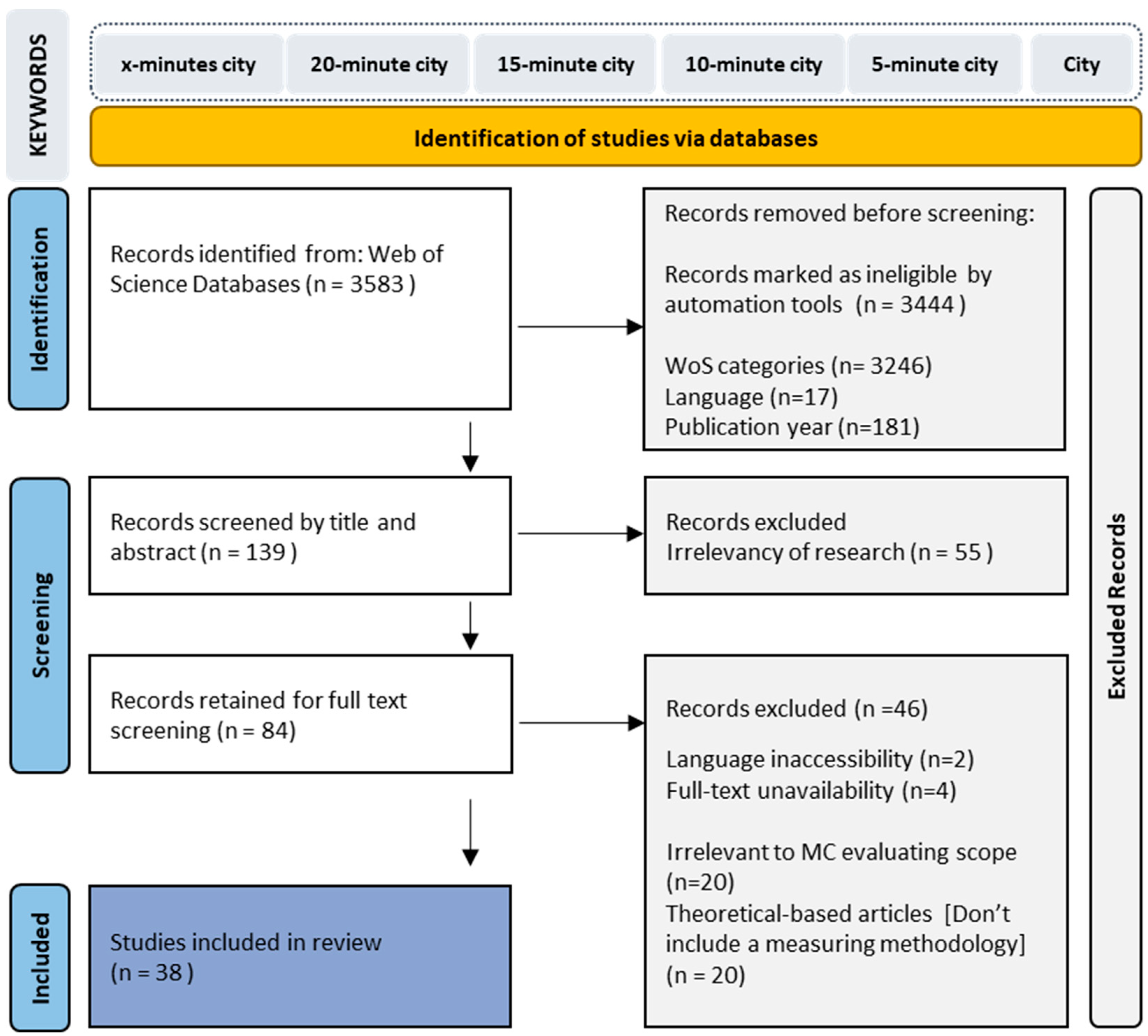






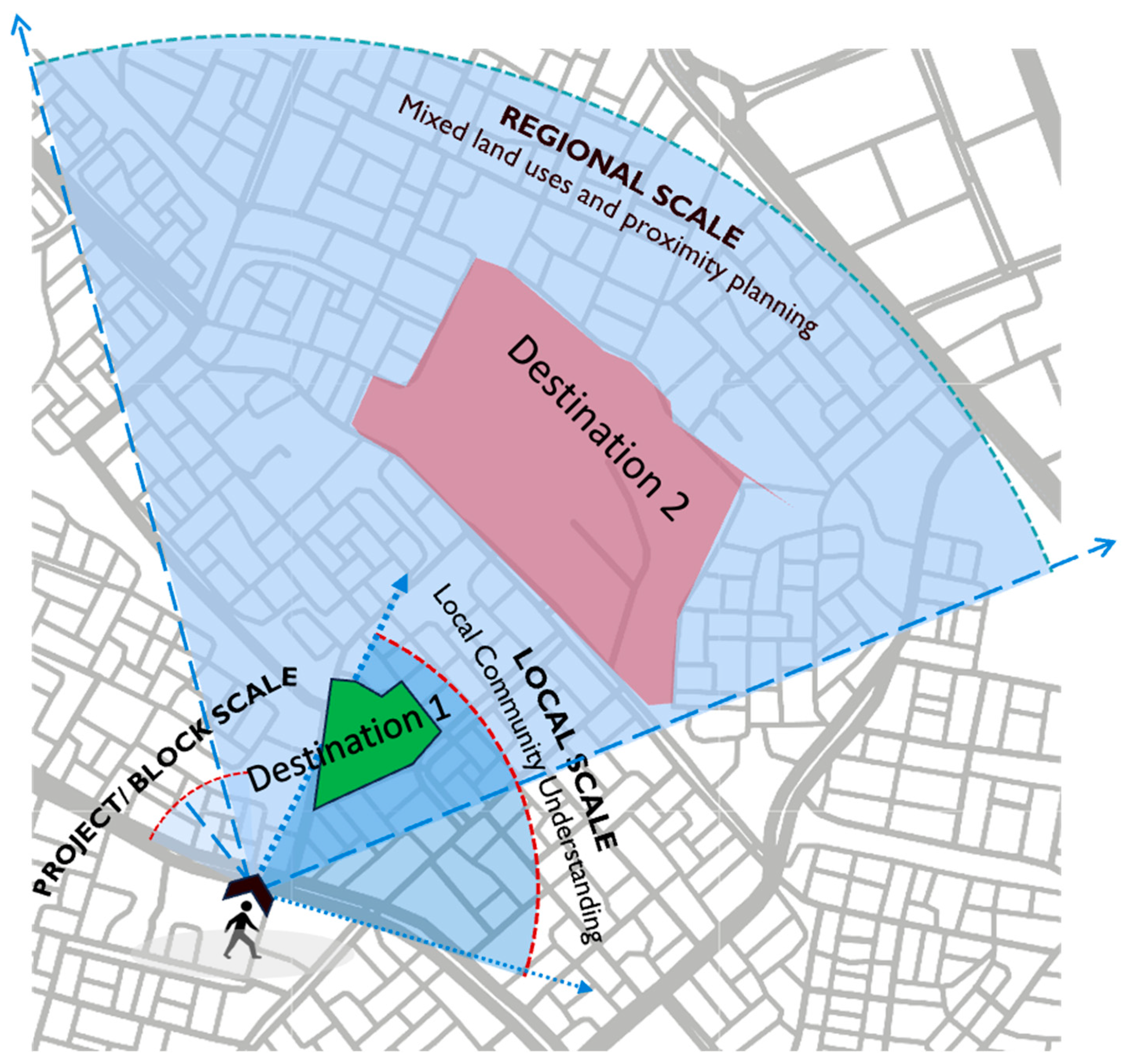

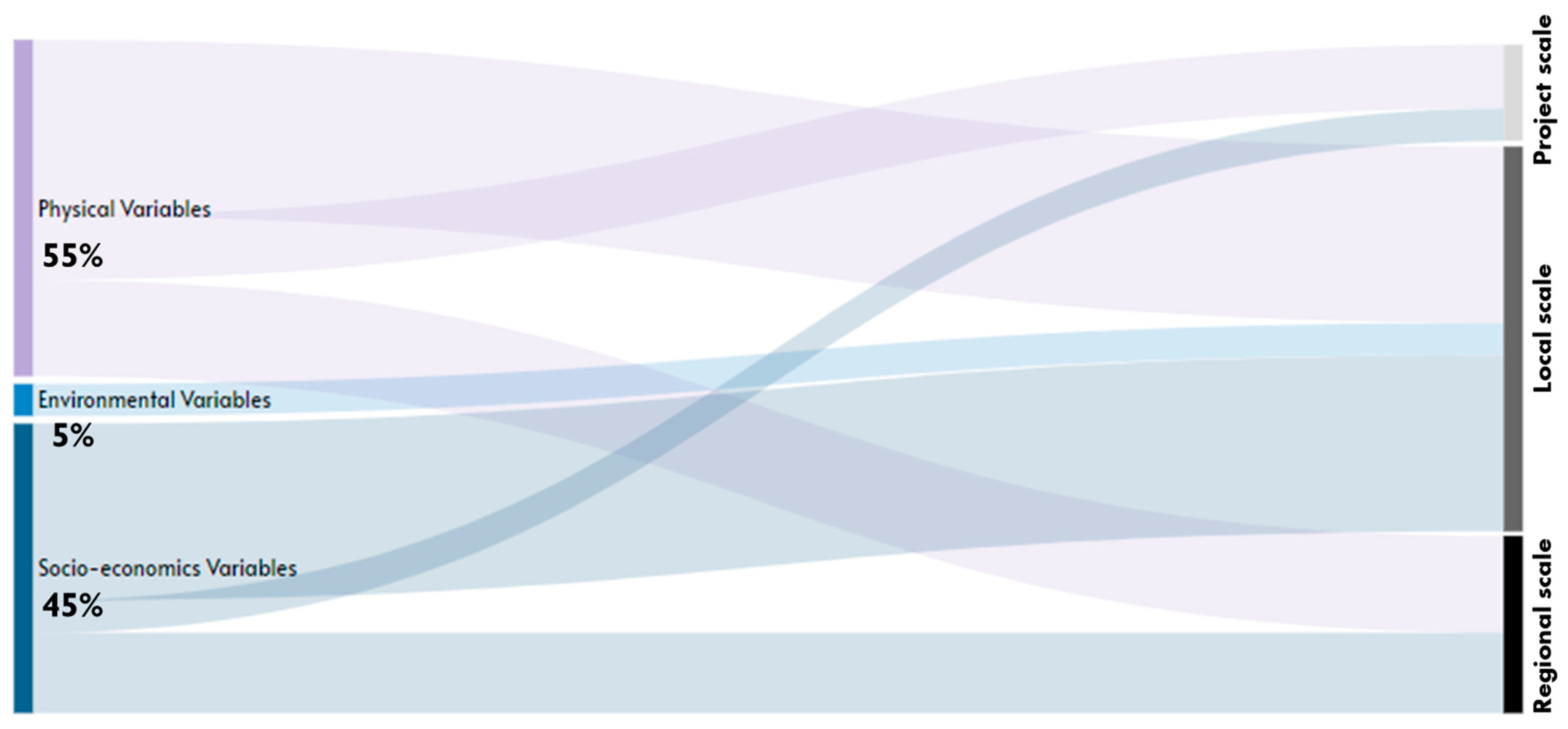
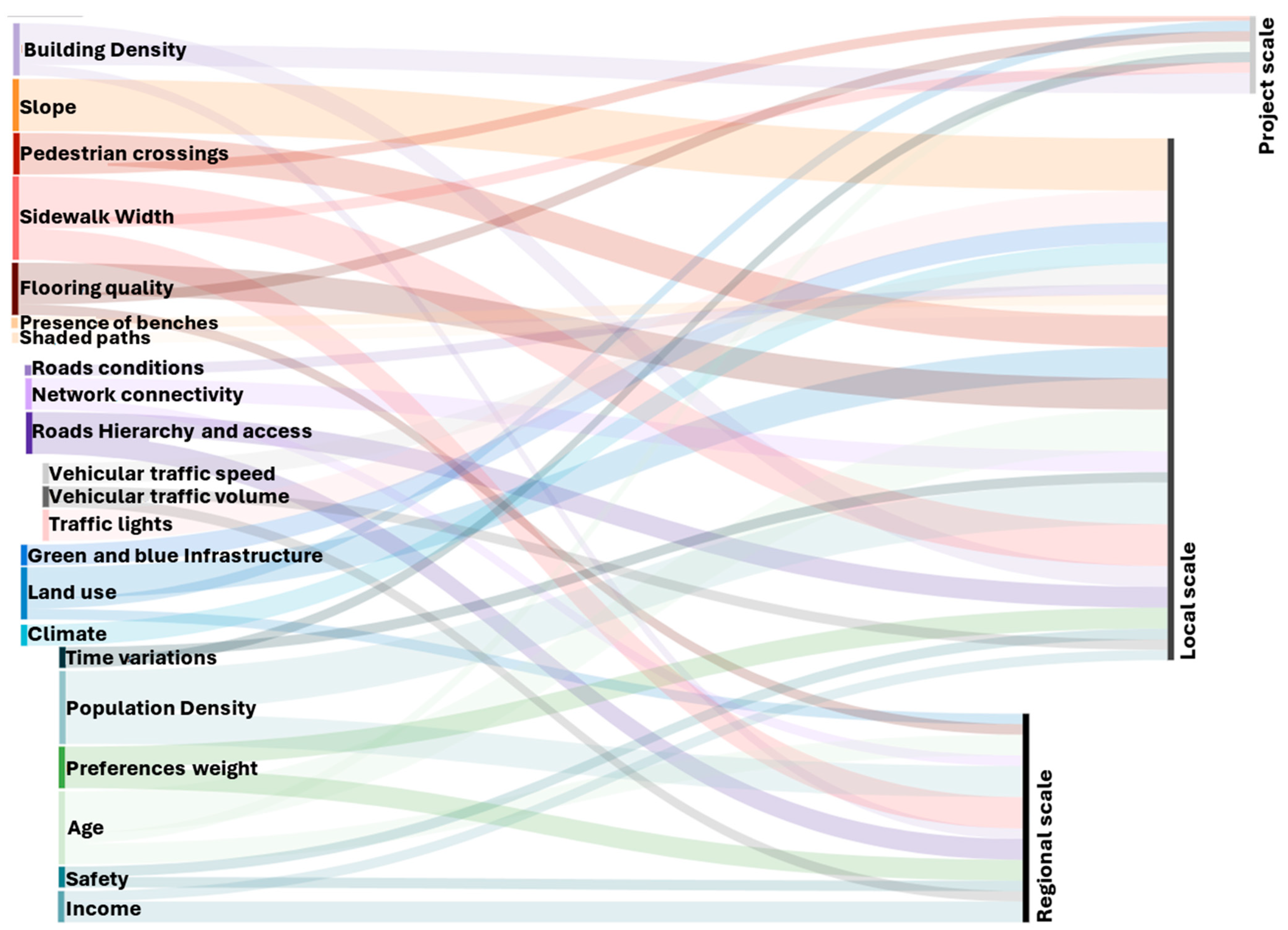
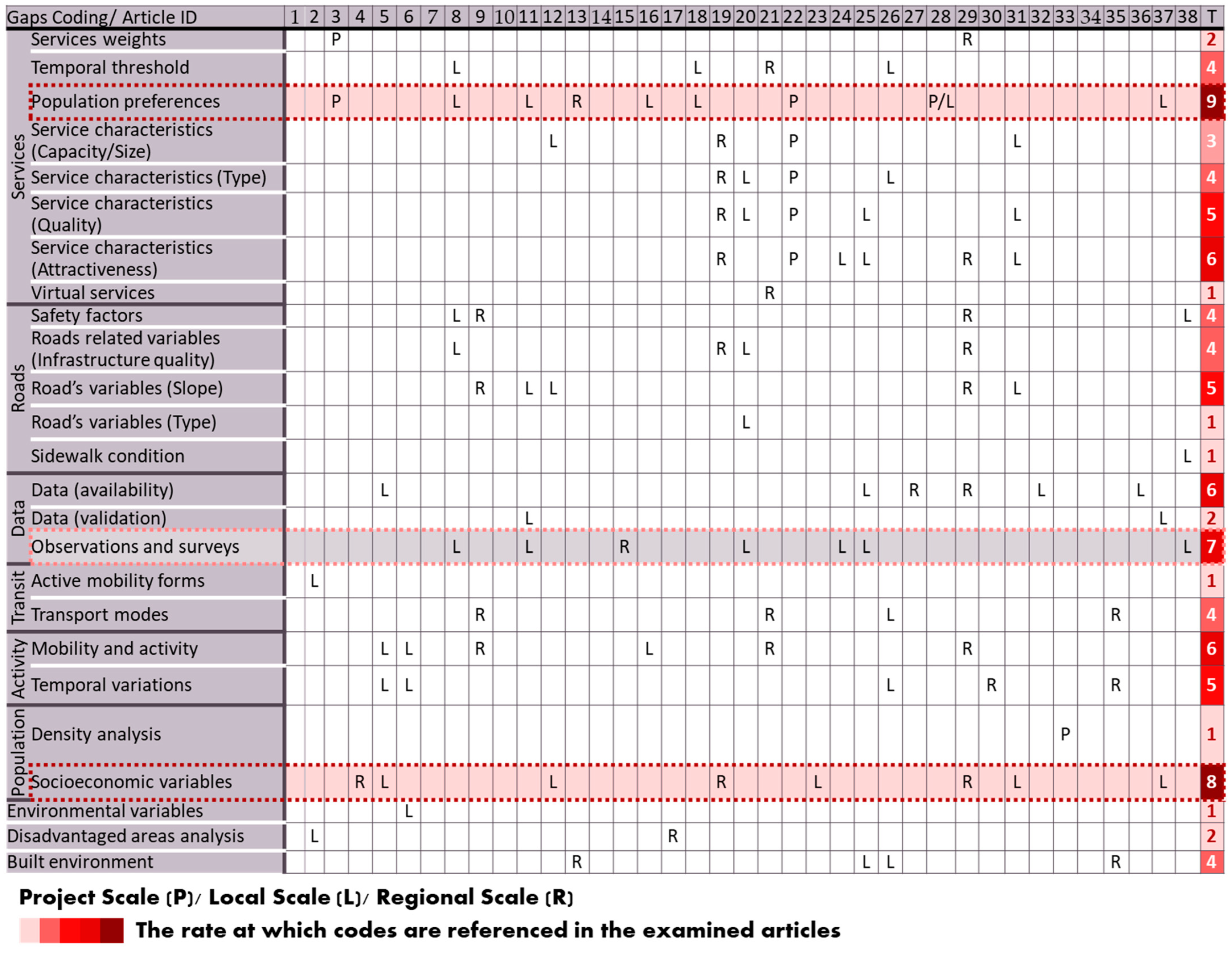
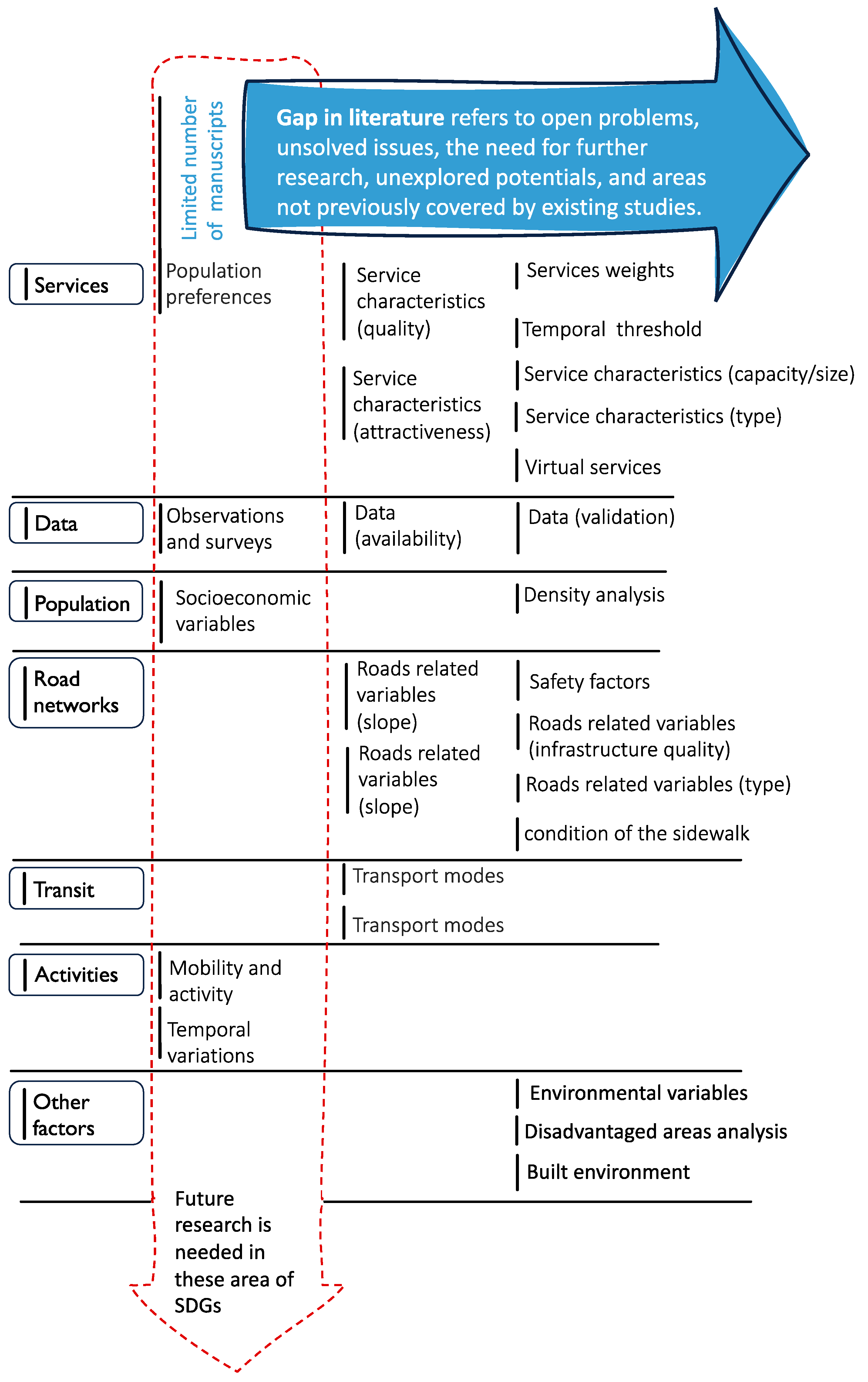
| Approach | References | |
|---|---|---|
| Approach 1: | Grid-based approach/Origin Destination Approach | [16,29,30,31,32,33] |
| Approach 2: | POI catchment area approach | [15,23,34,35,36,37,38,39,40,41,42,43,44] |
| Approach 3: | Building catchment area | [22,45,46,47,48] |
| Approach 4: | Mixed approach | [49,50,51,52] |
| Approach 5: | Network-based method/graph representation method | [53,54,55] |
| Approach 6: | Indicator/index-based method | [6,24,44,56,57] |
Disclaimer/Publisher’s Note: The statements, opinions and data contained in all publications are solely those of the individual author(s) and contributor(s) and not of MDPI and/or the editor(s). MDPI and/or the editor(s) disclaim responsibility for any injury to people or property resulting from any ideas, methods, instructions or products referred to in the content. |
© 2024 by the authors. Licensee MDPI, Basel, Switzerland. This article is an open access article distributed under the terms and conditions of the Creative Commons Attribution (CC BY) license (https://creativecommons.org/licenses/by/4.0/).
Share and Cite
Megahed, G.; Elshater, A.; Afifi, S.; Elrefaie, M.A. Reconceptualizing Proximity Measurement Approaches through the Urban Discourse on the X-Minute City. Sustainability 2024, 16, 1303. https://doi.org/10.3390/su16031303
Megahed G, Elshater A, Afifi S, Elrefaie MA. Reconceptualizing Proximity Measurement Approaches through the Urban Discourse on the X-Minute City. Sustainability. 2024; 16(3):1303. https://doi.org/10.3390/su16031303
Chicago/Turabian StyleMegahed, Gehad, Abeer Elshater, Samy Afifi, and Mohab Abdelmoneim Elrefaie. 2024. "Reconceptualizing Proximity Measurement Approaches through the Urban Discourse on the X-Minute City" Sustainability 16, no. 3: 1303. https://doi.org/10.3390/su16031303






